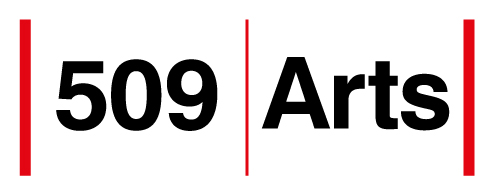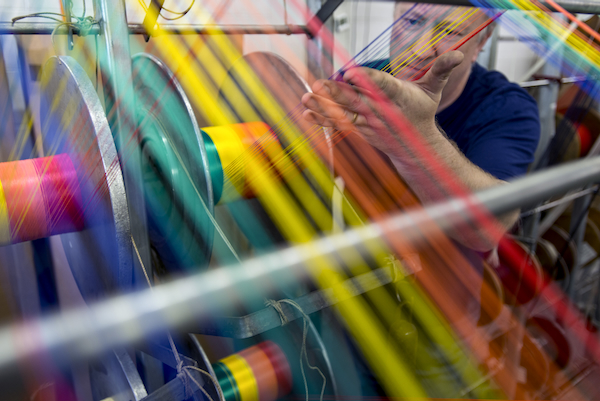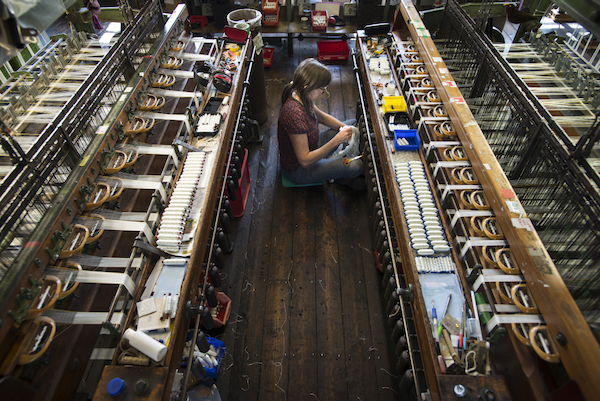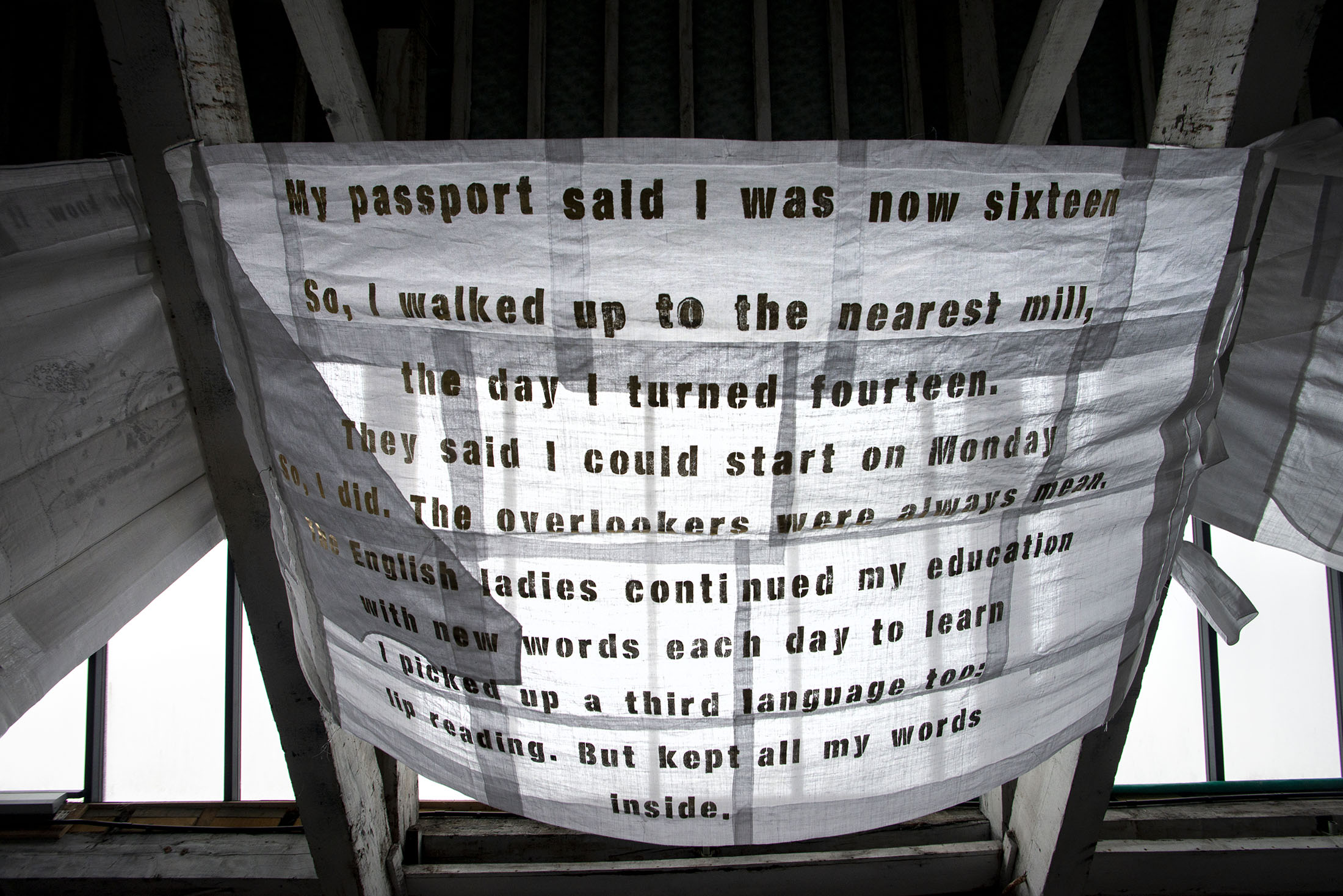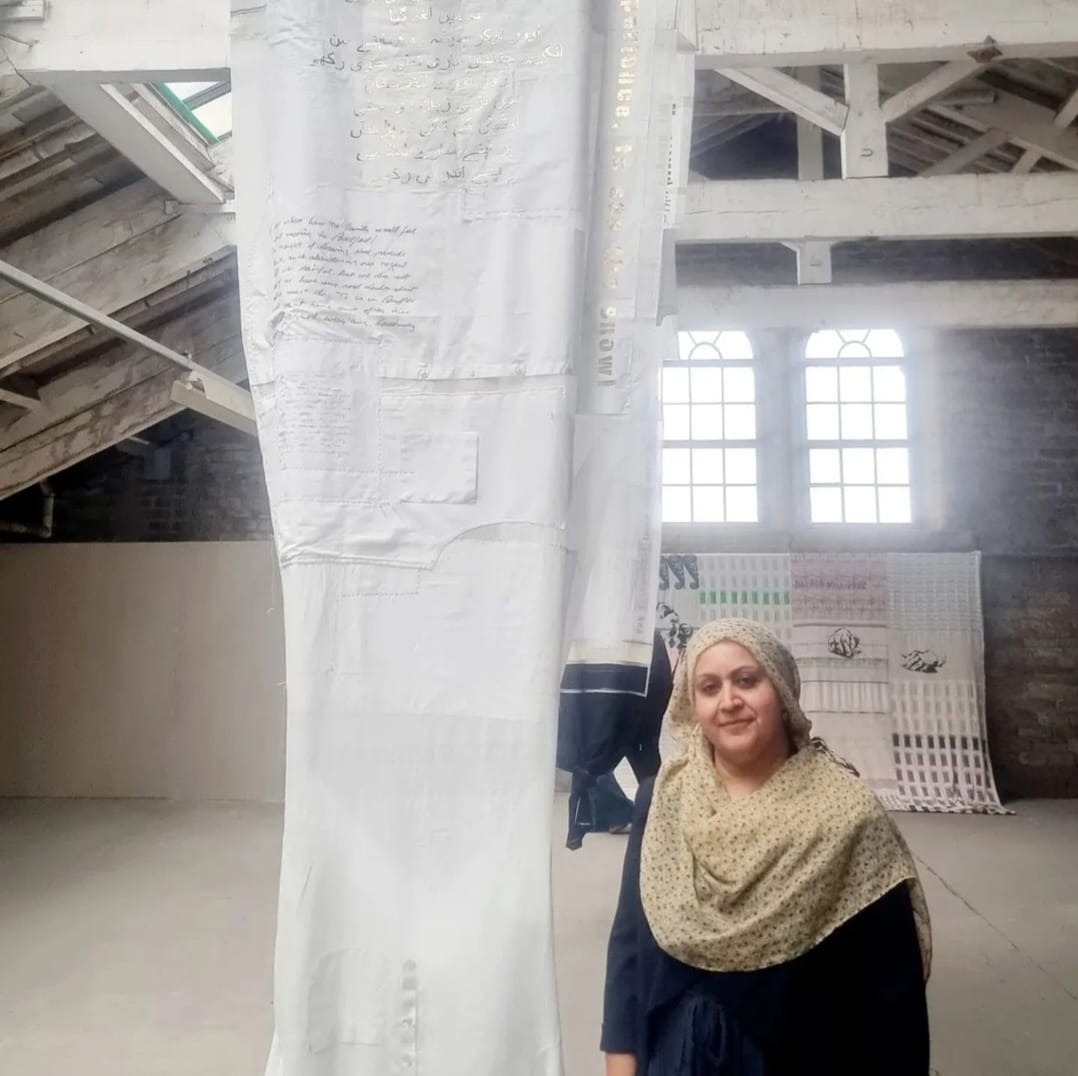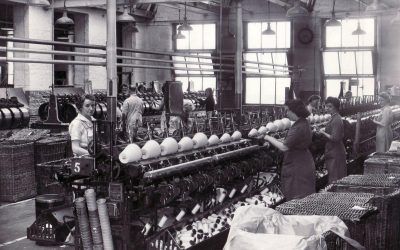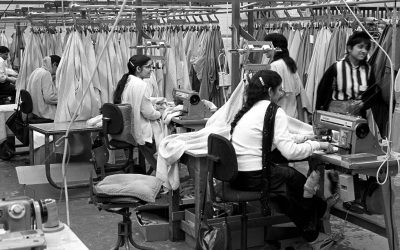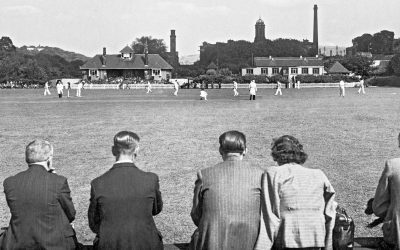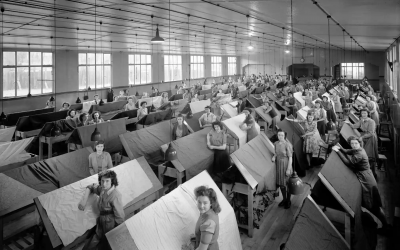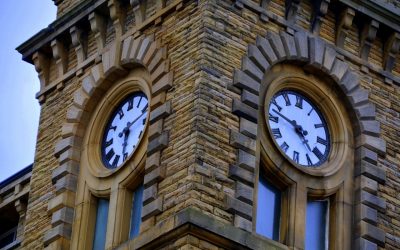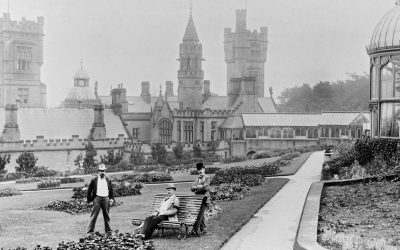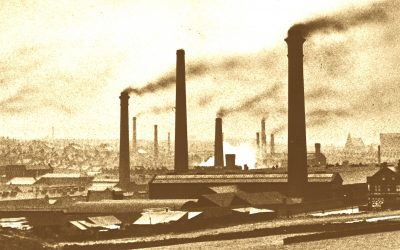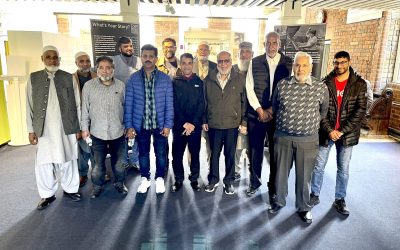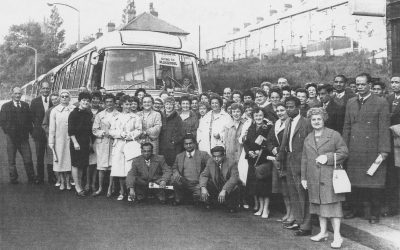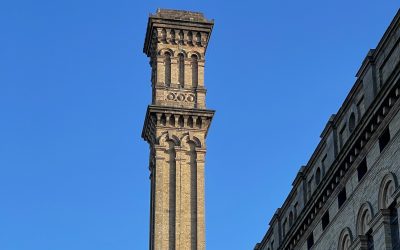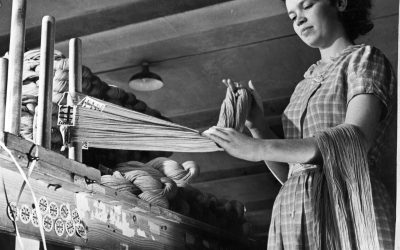In 2022, I saw this job. And I rang them up and said ‘I’m looking for a job as a textile spinner.’ They interviewed me, and they told me, ‘Oh, this is the machine, test it out.’ Even though I haven’t done it for about 40 years, I still know how to do it. And they says to me, ‘When do you want to start?’ I says, ‘I’ll start now!’ So I started the next day and I’m very satisfied. I feel so relaxed and it’s a lot of fun.
Today’s Textile Landscape
Compared to the 20th century, Bradford’s textile landscape in Bradford is very different. Although there are far fewer people working in the industry today, there has been a shift towards more sustainable and ethically produced textiles. Advancements in technology have revolutionised the manufacturing processes and the industry has diversified into niche markets and high-quality goods.
Keighley is home to Pennine Weavers, producing very high quality worsted cloth. Tradition lives on in Haworth, where Wyedean Weaving have been making material for uniforms since the 1960s. British Wool represents sheep farmers across the UK and is based in Bradford.
For a visual representation of textile companies operating today compared to those of the 1970s, please refer to the Lost Mills and Ghost Mansions Map under the Resources tab.
Pride Working in Bradford’s Textiles
Rebecca Ough | Transcript
I think it’s a really good career path is textiles and I do think that sometimes it’s overlooked in this area, but it’s a really growing industry. A lot of the really good textile companies in the area tend to be family run, have a really good community. And yeah, everyone I’ve worked with in textiles is really sort of interested and engaged in what they’re doing and do have a feeling of, yeah, pride about what they’re making because it’s, I think it’s… it is such a craft and a skill. And I think there’s so many different career options within textiles, like engineering, like mechanical engineering is a really big thing in textiles. So it’s not just the design side, it’s like, there’s a whole spectrum of different jobs.
Teaching Textiles in Bradford
Hannah Lamb and Hannah Robson | Transcript
HL: Hi, I’m Hannah Lamb and I’m a lecturer in textiles, but I’m also a textile artist. And my background is in stitched textiles, but I also do quite a lot of mixed media and printed textiles. And I’ve been teaching and working in the Bradford area for the past 20 years. And I’m just really fascinated with all aspects of textiles, I suppose.
HR: I’m Hannah Robson. I also teach with Hannah at Bradford School of Art. I’m a weaver and my background has been fully in weave in all sorts of different ways. And I teach woven textiles. And I’ve been recently obsessed with jacquard weaving, which has been a strong part of the project.
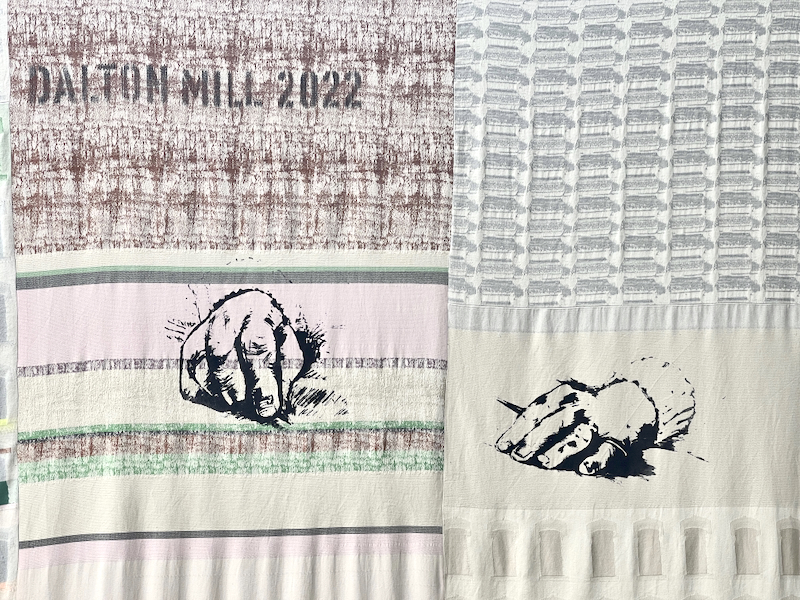
Photograph: Tim Smith | A close up of A Cloth for the Lost Mills
The Inspirations for Layering Cultures
Alison Welsh | Transcript
I’ve got a background in fashion design, so I knew that clothes were going to be an important part of this and what people wore in the mills to keep themselves warm because it was often cold. But also just the feeling of the 1970s and the flares and a 1970s shirt that’s see-through. I wanted a see-through 70s shirt to be included. Not that they would have worn that in the mill, I suppose! But because it’s white and it’s quite translucent I wanted it to feel sort of quite lightweight and transient. And because there’s a skylight above the piece I wanted to play with the light so that you could kind of see through it and give you an insight into the slightly ghostly quality on the ghost mills that the project is about.
Bradford’s textile industry today is very different from what it once was. The era of mass production may have ended but the pride in high quality manufacturing remains and the resilience and adaptability of the industry has paved the way for new textile technologies. Let’s delve deeper into Bradford’s textile industry in the 21st Century and explore the innovations and challenges it faces today.
The Modern Designing Method
Rebecca Ough | Transcript
My loom is semi computerized, so I do a lot of my design work on a computer, but a lot of the time actually it starts off with squared paper and I’m drawing out patterns before inputting it onto my computer. I guess it’s like the same process on a computer like I’ve got a grid which I’m drawing squares on so it’s still the same process, not much has changed in terms of that.
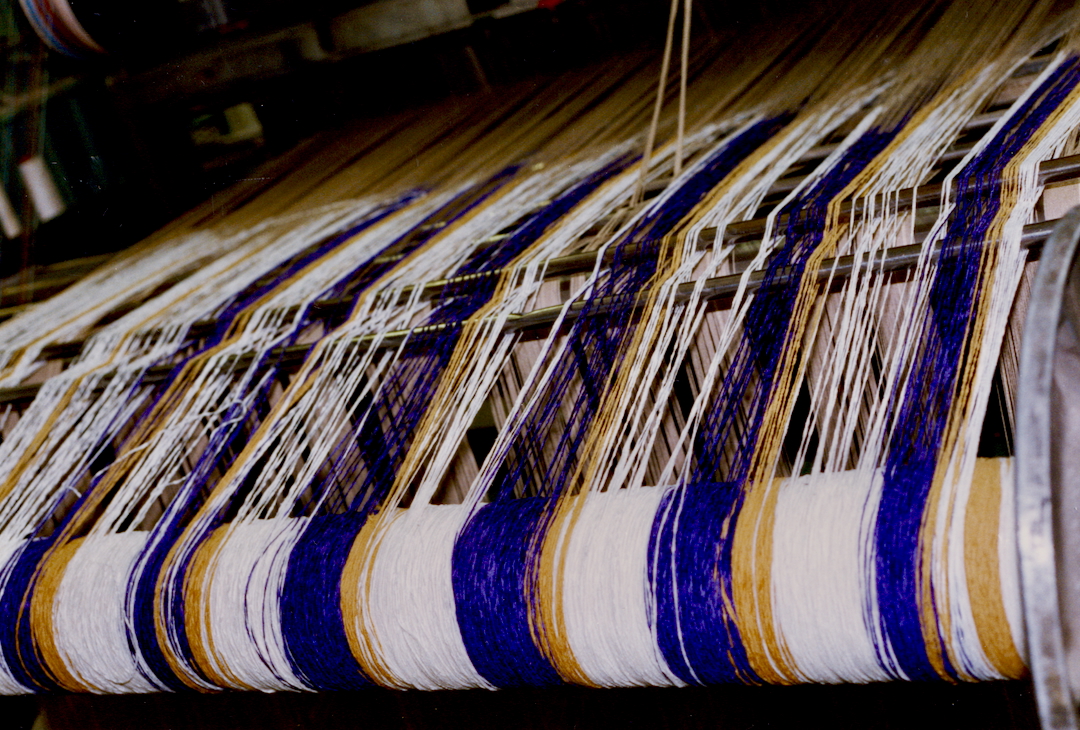
Photograph: Richard Smith | Fabric Making at E&S Smiths
The Truth Behind ‘Designed in Britain'
Kate Rawnsley | Transcript
You’ll often see, well it will say, ‘Designed in Britain.’ It’s not made in Britain; it’s just designed in Britain. So basically, you will do your design on the computer, wing it over to Indonesia or India or China where it gets woven, and they can be weaving it within the hour. Which is just mind-blowing. It’s incredible. But this is globalisation.
Practical Skills for Future Generations
Elisabeth Mitchell | Transcript
It saddens me. Because, as I say, around the corner there, I do hand spinning… and it does sadden me that…I’m not being sentimental… but we’re losing skills. And I know we don’t need to know how to do hand spinning and things like that now. But once these people have gone, people will no longer understand how things were processed. Or even how to use wool or fabric. I mean, you’ll see up there I still do a lot of craftwork, knitting and making things, and that. And it saddens me that all those things will be lost. Two of our granddaughters,…well, all three… have learned how to knit in a fashion, and use a sewing machine and things. But I don’t think their children will. And they’ll say, ‘Well it’s just an old fashioned thing.’
Lost Mills Textile Commissions
509 Arts commissioned two textile artworks by three local artists for the Saltaire Arts Trail, in partnership with Saltaire Inspired, in May 2024. These were displayed in Salts Mill before relocation to their new home at Bradford Industrial Museum.
A Cloth for the Lost Mills was created by Hannah Lamb and Hannah Robson. It is a large-scale woven and printed cloth inspired by site visits to lost textile mills. The cloth blends motifs from derelict mill buildings with archive images and is displayed with photography by Carolyn Mendelsohn of the cloth at lost mill sites.
Layering Cultures by Alison Welsh is a 7m long textile artwork based on the working clothes of the 1970’s and onwards interwoven with memories of mill workers and poetry by Nabeela Ahmed in both English and Pahari. It focuses onwards, referencing photographs of a cross-section of millworkers and bringing together a mix of cultures through their personal memories and life experiences.
Things to do...

As globalisation continues to shape our modern world, it is especially important to support and celebrate our local artists and businesses. Ways in which you can help small companies thrive can be by liking their social media posts or choosing to ‘shop local’ when buying gifts. Here are other ways to celebrate Bradford’s textiles today:
What to do next...
Take a trip to Bradford’s Industrial Museum! This is a great day out for the whole family, giving you the chance to see traditional machinery used firsthand by local experts, plus find the beautiful textile pieces commissioned from this project in their new, permanent home!
What to do next...
Using Nabeela Ahmed’s poetry as inspiration, write your own poem or creative writing piece based on textiles. Think of the colours, smells, sounds, and textures of the machinery and finished products involved to make it a sensory experience.
Discover More
Lost Mills
Lost Mills & Ghost Mansions
Photograph: Tim Smith | UNSPUN How To Use The Learning Zone is a rich and fascinating resource for all. Take your time to explore and discover the many stories and insights on offer. Whether you are a student, a teacher, a researcher, a community group or an...
Working life
Photograph: Tim Smith | Lifting hanks of wool from a dyeing vat at Harrison Gardner and Company. If you've seen old mills, pictures of old mills and that, you'll see that there's a big mill with five or six storeys. And then at the back of it, probably, there's a one...
Diverse workforce
Photographs: Bradford Museums & GalleriesBackground: Bradford Museums & Galleries Photograph: Tim Smith | Combing at Haworth Scouring CompanyBackground: Bradford Museums & Galleries Photograph: Jaz Oldham | Jaz's Sister and Friend working in the mill The...
Time Off
Background: Bradford Museums & Galleries | Cricket Match in Saltaire Photograph: Jaz Oldham | Party in the MillBackground: Bradford Museums & Galleries | Cricket Match in Saltaire Photograph: Patricia Crabtree | Harold Heppleston, Patricia's Father, and...
Rights & Wrongs
Photograph: Val Rowland | Anwar Hussain (L), Bill Morris, former General Secretary of the Transport and General Workers Union (C), and Muhammad Rasab (R). Representing the racial discrimination case against John Haggas Ltd onstage at the Trade Union Annual Congress...
Changing Ways
Photographs: Mark Stevenson | Dalton Mill and Clock Tower I could see at that time that the mills were starting to close around Keighley all over the town and I thought ‘I need to be moving on somewhere’ and that's when I left in 1975 and joined the fire service....
Ghost Mansions
I know that Robert Clough - he had a big mansion, and he donated a Christmas tree for the people of Keighley one year. Well, I won't be swayed on this at all. Particularly on a Friday night, when everybody else had gone home,...
Research & Map
Background Photograph: Bradford Museums & Galleries | Bradford's Skyline Title Photograph: Rainbow School | Visiting Bradford's Industrial Museum I grew up next to Marriner’s and I actually watched it burn down. It would have been in the ‘70s. I was in my...
Do It Yourself
Photograph: Alan Dix | Sangat Centre at Bradford Industrial Museum I think what people should do is show an interest in local history because one day (and I hope this never happens) there won’t be people like you, and there won’t be people like me, who...
Mediawall
Photograph: Margaret Dobson via Keighley and District Local History Society | Employees of John Haggas Ltd's Outing to Blackpool Lost Mills Media Wall Here we celebrate the rich visual history shared by contributors and project partners whilst researching Bradford's...
Archive
Photograph: Alan Dix | Lister's Mill ChimneyWelcome to the Lost Mills Archive. Here you will find all the recordings and transcripts that have been made during the lifetime of the project. It contains a wealth of information - far more than we could ever use in the...
Contributors
Thank you Lost Mills and Ghost Mansions has involved at least 500 people one way or another and their support, participation and commitment has taken us on a very special journey. Most of the people we interviewed were in their 70s and 80s and some were over 90. It is...
The contents of the 509 Arts website are protected by copyright unless otherwise stated. The Lost Mills Learning Zone recordings, text and activity suggestions are free to use for non-commercial community and education purposes. If you wish to use the materials for any other purpose, email info@509arts.co.uk with your plans.
Some of the images and video footage belong to a third party and are credited as such. If you wish to use any such content, please contact 509 Arts or the copyright owner directly.
